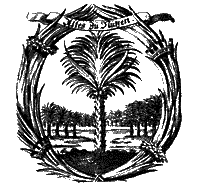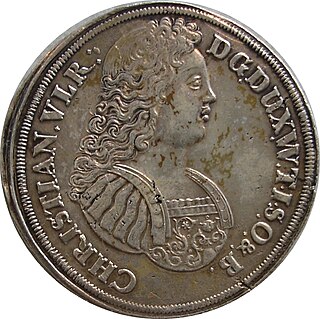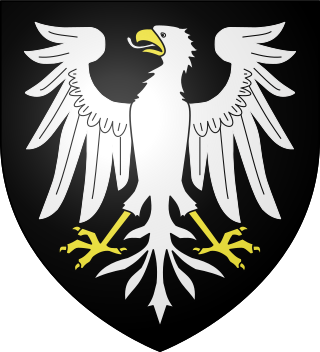
The Fruitbearing Society was a German literary society founded in 1617 in Weimar by German scholars and nobility. Its aim was to standardize vernacular German and promote it as both a scholarly and literary language, after the pattern of the Accademia della Crusca in Florence and similar groups already thriving in Italy, followed in later years also in France (1635) and Britain.

Anna Maria of Mecklenburg-Schwerin was a German noblewoman, a member of the House of Mecklenburg and by marriage Duchess of Saxe-Weissenfels.

Frederick II, Duke of Saxe-Gotha-Altenburg, was a duke of Saxe-Gotha-Altenburg.

Johann Georg I, Duke of Saxe-Eisenach was the fifth but third surviving son of Wilhelm, Duke of Saxe-Weimar and Eleonore Dorothea of Anhalt-Dessau.

Augustus of Saxe-Weissenfels, was a Duke of Saxe-Weissenfels-Querfurt of the House of Wettin and administrator of the Archbishopric of Magdeburg.

Johann Adolf I, Duke of Saxe-Weissenfels, was a duke of Saxe-Weissenfels-Querfurt and member of the House of Wettin. He was the first son of Augustus, Duke of Saxe-Weissenfels, and his first wife, Anna Maria of Mecklenburg-Schwerin.

Johann Georg, was Duke of Saxe-Weissenfels from 1697 until his death.

Johann Adolf II was the last Duke of Saxe-Weissenfels from 1736 to 1746. Following his death without surviving male issue, the Duchy returned to Electoral Saxony. Johann Adolf was also a commander in the Saxon Army.

Georg Albrecht of Saxe-Weissenfels, Count of Barby, was a German prince of the House of Wettin and the last count of Barby.

Saxe-Weissenfels was a Duchy of the Holy Roman Empire from 1656 until 1746 with its residence at Weißenfels. Ruled by a cadet branch of the Albertine House of Wettin, the duchy passed to the Electorate of Saxony upon the extinction of the line.
Albert II, Prince of Anhalt-Zerbst was a German prince of the House of Ascania and ruler of the principality of Anhalt-Zerbst.
Sigismund I, Prince of Anhalt-Dessau, was a German prince of the House of Ascania and ruler of the principality of Anhalt-Zerbst until 1396, when he became the first ruler of the principality of Anhalt-Dessau. He was the eldest son of John II, Prince of Anhalt-Zerbst, by his wife Elisabeth, daughter of John I, Count of Henneberg-Schleusingen.

John V of Anhalt-Zerbst, was a German prince of the House of Ascania and ruler of the principality of Anhalt-Dessau. From 1544, he assumed rule of the re-created principality of Anhalt-Zerbst.

Joachim Ernest of Anhalt, was a German prince of the House of Ascania, ruler of the principality of Anhalt-Zerbst from 1551, and from 1570 sole ruler of all the Anhalt lands.

John George I of Anhalt-Dessau was a German prince of the House of Ascania. From 1586 to 1603 he ruled the unified principality of Anhalt jointly with his brothers. After the partition of the principality in 1603, he ruled the principality of Anhalt-Dessau from 1603 to 1618.

Duke Christian Ulrich I of Württemberg-Oels was a German nobleman. He was the ruling Duke of Württemberg-Bernstadt from 1669 to 1697 and then the ruling Duke of Oels-Württemberg from 1697 until his death.

Elisabeth Albertine of Anhalt-Dessau, was a German noblewoman by birth Princess of Anhalt-Dessau as member of the House of Ascania and by marriage Duchess of Saxe-Weissenfels-Barby.

The Arnstein family was a noble family from the Saxony-Anhalt region in Germany.















